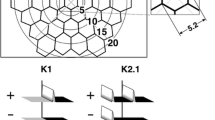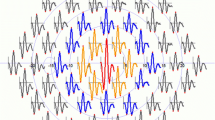Abstract
Purpose
The clinical standards for multifocal electroretinograms (mfERG) call for adaption to normal room lighting before the mfERG begins. They specify that any assessments where bright lights are used, should be done after the mfERG to prevent excess stimulation of retinal cells. However, full-field electroretinograms (FFERG) are performed prior to mfERGs in some clinical settings. It is unclear from the literature whether the FFERG has an impact on the mfERG. This study seeks to examine the effect of the FFERG on the mfERG when performed sequentially.
Methods
Thirty young healthy subjects (age 27.1 ± 3.5 years) were included. Patients reported for two visits and were fully dilated at both visits. At visit one, a FFERG was recorded (VERIS 6.2) using our clinical protocol which includes an ISCEV standard flash sequence; each flash condition was repeated 4–6 times. Following the FFERG, an mfERG was recorded using a 4-min m-sequence at near 100% contrast. At visit two, only the mfERG was recorded. A Burian–Allen contact lens electrode filled with celluvisc was used for all recordings. The two mfERGs were compared for foveal, peripheral, and overall implicit time (IT) and amplitudes (amp). Paired t tests were used to evaluate the data. Coefficient of variation and Bland–Altman analysis was also reported for this patient group.
Results
There was a small but statistically significant difference in foveal amplitudes (amp) (p = 0.004) wherein the amp was larger following the FFERG stimuli. The mean difference was 11.1 nV/deg2 (100.9 nV vs 89.8 nV). There was no difference in foveal IT (p = 0.66). There was no difference in overall IT or amp when averaging the entire eye (p = 0.44 amp and p = 0.54 IT) or just evaluating the periphery (p = 0.87 amp and p = 0.051 IT). Bland–Altman analysis found a coefficient of repeatability overall was 1.57 ms (IT) and 10.7 nV/deg2 (amp).
Conclusions
The difference in foveal amplitude is likely the result of a small long-term cone adaptation, but further studies are needed. While it is statistically significant, the small difference is unlikely to be clinically important. These results should help increase clinical confidence in mfERG results when recorded following a FFERG.


Similar content being viewed by others
References
Hood DC, Bach M, Brigell M, Keating D, Kondo M, Lyons JS, Marmor MF, McCulloch DL, Palmowski-Wolfe AM, International Society For Clinical Electrophysiology of Vision (2012) ISCEV standard for clinical multifocal electroretinography (mfERG) (2011 edition). Doc Ophthalmol 124(1):1–13. https://doi.org/10.1007/s10633-011-9296-8
Bearse MA Jr, Sutter EE (1996) Imaging localized retinal dysfunction with the multifocal electroretinogram. J Opt Soc Am A Opt Image Sci Vis 13(3):634–640
Kretschmann U, Tornow RP, Zrenner E (1998) Multifocal ERG reveals long distance effects of a local bleach in the retina. Vis Res 38(11):1567–1571
Chappelow AV, Marmor MF (2002) Effects of pre-adaptation conditions and ambient room lighting on the multifocal ERG. Doc Ophthalmol 105(1):23–31
Gouras P, MacKay CJ (1989) Growth in amplitude of the human cone electroretinogram with light adaptation. Investig Ophthalmol Vis Sci 30(4):625–630
Weiner A, Sandberg MA (1991) Normal change in the foveal cone ERG with increasing duration of light exposure. Investig Ophthalmol Vis Sci 32(10):2842–2845
Kondo M, Miyake Y, Piao CH, Tanikawa A, Horiguchi M, Terasaki H (1999) Amplitude increase of the multifocal electroretinogram during light adaptation. Investig Ophthalmol Vis Sci 40(11):2633–2637
Suresh S, Tienor BJ, Smith SD, Lee MS (2016) The effects of fundus photography on the multifocal electroretinogram. Doc Ophthalmol 132(1):39–45. https://doi.org/10.1007/s10633-016-9525-2
Biancardi N, Colburn B, Johnson C, Nelson Z (2017) Pupil testing makes foveal amplitudes significantly larger in mfERG Testing. Paper presented at the American Academy of Optometry, Chicago, IL
Sachidanandam R, Ravi P, Sen P (2017) Effect of axial length on full-field and multifocal electroretinograms. Clin Exp Optom 100(6):668–675. https://doi.org/10.1111/cxo.12529
Gundogan FC, Sobaci G, Bayraktar MZ (2008) Intra-sessional and inter-sessional variability of multifocal electroretinogram. Doc Ophthalmol 117(3):175–183. https://doi.org/10.1007/s10633-008-9119-8
Garcia-Garcia A, Munoz-Negrete FJ, Rebolleda G (2016) Variability of the multifocal electroretinogram based on the type and position of the electrode. Doc Ophthalmol 133(2):99–108. https://doi.org/10.1007/s10633-016-9560-z
Gonzalez P, Parks S, Dolan F, Keating D (2004) The effects of pupil size on the multifocal electroretinogram. Doc Ophthalmol 109(1):67–72
Browning DJ, Lee C (2014) Test-retest variability of multifocal electroretinography in normal volunteers and short-term variability in hydroxychloroquine users. Clin Ophthalmol 8:1467–1473. https://doi.org/10.2147/OPTH.S66528
Harrison WW, Bearse MA Jr, Ng JS, Barez S, Schneck ME, Adams AJ (2009) Reproducibility of the mfERG between instruments. Doc Ophthalmol 119(1):67–78. https://doi.org/10.1007/s10633-009-9171-z
Acknowledgements
We would like to thank Dr. Marcus Bearse for his guidance as this project was formed. We thank Brian Colburn, Chris Johnson, and Zak Nelson for their help in follow-up data. We also thank Vicki Kimberlin, Donna Oller, and Julie Welch for their assistance in the Midwestern Eye Institute. We thank Kimberly Thompson for her help with figures. This work has been partially presented at the 2017 ARVO meeting and the 2018 ISCEV@ARVO meeting.
Funding
This study was funded by an internal grant to Wendy Harrison and Kaila Osmotherly from the Midwestern University Office of Research and Sponsored Projects.
Author information
Authors and Affiliations
Corresponding author
Ethics declarations
Conflict of interest
Wendy Harrison declares she has no conflict of interest. Kaila Osmotherly declares she has no conflict of interest. Nathan Biancardi declares he has no conflict of interest. Jamison Langston declares he has no conflict of interest. Russell Gray declares he has no conflict of interest. Taylor Kneip declares he has no conflict of interest. Reese Loveless declares he has no conflict of interest.
Statement of human rights
All procedures performed in studies involving human participants were in accordance with the ethical standards of the institutional and/or national research committee and with the 1964 Helsinki declaration and its later amendments or comparable ethical standards.
Statement on the welfare of animals
There were no animals used in this study.
Informed consent
Informed consent was obtained from all individual participants included in the study.
Rights and permissions
About this article
Cite this article
Harrison, W., Osmotherly, K., Biancardi, N. et al. Foveal amplitudes of multifocal electroretinograms are larger following full-field electroretinograms. Doc Ophthalmol 137, 143–149 (2018). https://doi.org/10.1007/s10633-018-9657-7
Received:
Accepted:
Published:
Issue Date:
DOI: https://doi.org/10.1007/s10633-018-9657-7




